Optimal Operation of a Two-Level Game for Community Integrated Energy Systems Considering Integrated Demand Response and Carbon Trading
Abstract
1. Introduction
- (1)
- A segmentation of users on the basis of their energy-use characteristics is conducted, and the results demonstrate that this segmentation allows user aggregators to more effectively participate in the demand–response market and improve user-side benefits.
- (2)
- A two-level game optimization model is proposed, wherein the ER, acting as a leader, forms an SMMS model with the ESs and a user aggregator, who are designated as followers. Non-cooperative games are established among the follower ESs, coordinating the interests of each ES. Additionally, to increase user benefits and reduce system carbon emissions, IDR and the CTM are introduced into the two-level game optimization model.
- (3)
- To assess the formulated model, an improved differential evolutionary algorithm is employed in collaboration with the CPLEX solver (v12.6). The case study verifies the convergence of the algorithm and the efficacy of the strategy proposed in this paper in considering the benefits of the various agents while reducing carbon emissions.
2. CIES Structure
3. The CIES Optimization Model Considering Both IDR and CTM
3.1. Modeling of New Energy CCHP
3.2. Modeling of CTM
3.3. Modeling the Benefits of Each Agent
3.3.1. Energy Retailer
3.3.2. Energy Suppliers
3.3.3. User Aggregator
4. Two-Level Game Model
4.1. The Model of Master–Slave Game
- (1)
- Participants: The ER, ES, and user aggregator.
- (2)
- Strategies: The ER’s strategy comprises two elements. The first is the aggregator of the prices of electricity and heat sold to the user, and the second is the purchasing power of electricity and heat from ESi, which is expressed as . The strategy for each ES refers to the price of energy sold, which is expressed as . Finally, the user aggregation strategy employs the quantity of load response at each moment in time, which is expressed as .
- (3)
- Benefits: As previously outlined, the benefits for each agent are calculated according to Equations (19), (30), and (40).
4.2. The Model of the Non-Cooperative Game
- (1)
- Participants: n ESs.
- (2)
- Strategy: The strategy for each ES is the price of electricity and heating, denoted as .
- (3)
- Benefits: The value of the ES objective function, as described earlier, is calculated using Equation (30).
4.3. Game Equilibrium Solution
4.3.1. Stackelberg Equilibrium Solution
- (1)
- The utility functions of the game participants are non-empty, continuous functions on the set of game strategies.
- (2)
- In accordance with the strategy adopted by the ER, a unique optimal solution exists for each ES and user aggregator.
- (3)
- In accordance with the strategies adopted by each ES and user aggregator, a unique optimal solution exists for the ER.
- (1)
- In accordance with the aforementioned description, the strategies of the leader ER must satisfy the conditions set forth in Equations (24)–(29), while the strategies of each ES must satisfy the conditions outlined in Equations (34)–(39). Additionally, the strategies of the user aggregator must satisfy the criteria specified in Equations (42)–(46). This ensures that the set of strategies for each participant is non-empty and tightly convex.
- (2)
- Once the purchased energy powers and of ER are defined, it can be observed that the return of each ES varies linearly with the decision according to Equation (30), so a unique solution is possible for each ES, which can be expressed as
- (3)
- We assume that the ER must purchase electricity and heat from the higher level in order to satisfy user demand. Then, the optimal solutions of the ES and user aggregator obtained from the above proof are incorporated into Equation (19), and the second-order partial derivatives of , , , and are calculated.
4.3.2. Nash Equilibrium for Non-Cooperative Game
5. Model Solving
6. Case Study
6.1. Basic Data
6.2. Analysis of Game Equilibrium Results
6.3. Optimal Scheduling Analysis
6.4. Analysis of Different Operational Modes
7. Conclusions
- (1)
- The introduction of non-cooperative games between ESs has been demonstrated to be an effective strategy for increasing profits. The implementation of non-cooperative game strategies among ESs can enhance the profitability of ES1 and ES2 by 27.83% and 18.67%, respectively. In comparison to a fixed energy sales price strategy, a non-cooperative game allows ESs to participate more effectively in market competition, which is conducive to the synergistic and optimal development of multiple agents.
- (2)
- The introduction of IDR can increase user revenue while reducing the system’s carbon emissions. The incorporation of IDR into the optimization model has been demonstrated to enhance user-side benefits by 25.79% while simultaneously curtailing the system’s carbon emissions by 22.42%. Concurrently, the introduction of the CTM can significantly reduce the carbon emissions of the system. The incorporation of the CTM results reduces the benefits associated with ES1 and ES2 by 31.97% and 43.09%, respectively. However, this is accompanied by a 32.01% decrease in the system’s carbon emissions, which aligns with the present requirements for achieving low-carbon IES.
- (3)
- Classifying users enables those on the demand side to participate more effectively in the demand–response market, thereby increasing revenue. The implementation of user classification can enhance user-level benefits by up to 39.51%. Once users have been categorized according to their energy-use characteristics, they are better positioned to engage with IDR and derive the greatest benefit from it.
Author Contributions
Funding
Data Availability Statement
Conflicts of Interest
References
- Firouzi, M.; Samimi, A.; Salami, A. Reliability evaluation of a composite power system in the presence of renewable generations. Reliab. Eng. Syst. Saf. 2022, 222, 108396. [Google Scholar] [CrossRef]
- Zhang, G.M.; Wang, W.; Chen, Z.Y.; Li, R.L.; Niu, Y.G. Modeling and optimal dispatch of a carbon-cycle integrated energy system for low-carbon and economic operation. Energy 2022, 240, 122795. [Google Scholar] [CrossRef]
- Fan, W.; Liu, Q.; Wang, M.Y. Bi-Level Multi-Objective Optimization Scheduling for Regional Integrated Energy Systems Based on Quantum Evolutionary Algorithm. Energies 2021, 14, 4740. [Google Scholar] [CrossRef]
- Wang, Y.L.; Wang, Y.D.; Huang, Y.J.; Yu, H.Y.; Du, R.T.; Zhang, F.L.; Zhang, F.; Zhu, J. Optimal Scheduling of the Regional Integrated Energy System Considering Economy and Environment. IEEE Trans. Sustain. Energy 2019, 10, 1939–1949. [Google Scholar] [CrossRef]
- Ma, Y.; Wang, H.; Hong, F.; Yang, J.; Chen, Z.; Cui, H.; Feng, J. Modeling and optimization of combined heat and power with power-to-gas and carbon capture system in integrated energy system. Energy 2021, 236, 121392. [Google Scholar] [CrossRef]
- Qiu, S.; Chen, J.; Mao, C.; Duan, Q.; Ma, C.; Liu, Z.; Wang, D. Day-ahead optimal scheduling of power–gas–heating integrated energy system considering energy routing. Energy Rep. 2022, 8, 1113–1122. [Google Scholar] [CrossRef]
- Parrish, B.; Heptonstall, P.; Gross, R.; Sovacool, B.K. A systematic review of motivations, enablers and barriers for consumer engagement with residential demand response. Energy Policy 2020, 138, 111221. [Google Scholar] [CrossRef]
- Wang, Y.Y.; Guo, T.T.; Cheng, T.C.E.; Wang, N. Evolution of blue carbon trading of China’s marine ranching under the blue carbon special subsidy mechanism. Ocean Coast. Manag. 2022, 222, 106123. [Google Scholar] [CrossRef]
- Li, P.; Wang, Z.X.; Wang, N.; Yang, W.H.; Li, M.Z.; Zhou, X.C.; Yin, Y.; Wang, J.; Guo, T. Stochastic robust optimal operation of community integrated energy system based on integrated demand response. Int. J. Electr. Power Energy Syst. 2021, 128, 106735. [Google Scholar] [CrossRef]
- Zheng, S.L.; Sun, Y.; Li, B.; Qi, B.; Zhang, X.D.; Li, F. Incentive-based integrated demand response for multiple energy carriers under complex uncertainties and double coupling effects. Appl. Energy 2021, 283, 116254. [Google Scholar] [CrossRef]
- Wang, Y.L.; Li, Y.W.; Zhang, Y.F.; Xu, M.M.; Li, D.X. Optimized operation of integrated energy systems accounting for synergistic electricity and heat demand response under heat load flexibility. Appl. Therm. Eng. 2024, 243, 122640. [Google Scholar] [CrossRef]
- Liang, Z.; Liang, C.; Zhu, W.W.; Ling, L.Y.; Cai, G.W.; Hai, K.L. Research on the optimal allocation method of source and storage capacity of integrated energy system considering integrated demand response. Energy Rep. 2022, 8, 10434–10448. [Google Scholar]
- Wang, J.; Xing, H.J.; Wang, H.X.; Xie, B.J.; Luo, Y.F. Optimal Operation of Regional Integrated Energy System Considering Integrated Demand Response and Exergy Efficiency. J. Electr. Eng. Technol. 2022, 17, 2591–2603. [Google Scholar] [CrossRef]
- Zhou, W.; Sun, Y.H.; Zong, X.J.; Zhou, H.W.; Zou, S. Low-carbon economic dispatch of integrated energy system considering carbon trading mechanism and LAES-ORC-CHP system. Front. Energy Res. 2023, 11. [Google Scholar] [CrossRef]
- Liu, X.O. Research on optimal placement of low-carbon equipment capacity in integrated energy system considering carbon emission and carbon trading. Int. J. Energy Res. 2022, 46, 20535–20555. [Google Scholar] [CrossRef]
- Cheng, X.; Zheng, Y.; Lin, Y.; Chen, L.; Wang, Y.Q.; Qiu, J. Hierarchical operation planning based on carbon-constrained locational marginal price for integrated energy system. Int. J. Electr. Power Energy Syst. 2021, 128, 106714. [Google Scholar] [CrossRef]
- Pan, D.; Zhang, L.; Wang, B.; Jia, J.X.; Song, Z.M.; Zhang, X. Multi-objective planning of integrated energy system based on CVaR under carbon trading mechanism. Front. Energy Res. 2024, 12. [Google Scholar] [CrossRef]
- Li, L.L.; Miao, Y.; Lin, C.J.; Qu, L.N.; Liu, G.C.; Yuan, J.P. Low-carbon Economic Operation Optimization of Integrated Energy System Considering Carbon Emission Sensing Measurement System and Demand Response: An Improved Northern Goshawk Optimization Algorithm. Sens. Mater. 2023, 35, 4417–4437. [Google Scholar] [CrossRef]
- Sun, H.B.; Sun, X.M.; Kou, L.; Ke, W.D. Low-Carbon Economic Operation Optimization of Park-Level Integrated Energy Systems with Flexible Loads and P2G under the Carbon Trading Mechanism. Sustainability 2023, 15, 15203. [Google Scholar] [CrossRef]
- Chen, M.; Lu, H.; Chang, X.; Liao, H. An optimization on an integrated energy system of combined heat and power, carbon capture system and power to gas by considering flexible load. Energy 2023, 273, 127203. [Google Scholar] [CrossRef]
- Zeng, X.Q.; Wang, J.; Zhou, Y.; Li, H.J. Optimal configuration and operation of the regional integrated energy system considering carbon emission and integrated demand response. Front. Energy Res. 2023, 11. [Google Scholar] [CrossRef]
- Huang, Y.J.; Wang, Y.D.; Liu, N. A two-stage energy management for heat-electricity integrated energy system considering dynamic pricing of Stackelberg game and operation strategy optimization. Energy 2022, 244, 122576. [Google Scholar] [CrossRef]
- Yarar, N.; Yoldas, Y.; Bahceci, S.; Onen, A.; Jung, J. A Comprehensive Review Based on the Game Theory with Energy Management and Trading. Energies 2024, 17, 3749. [Google Scholar] [CrossRef]
- Zhang, Y.Y.; Zhao, H.R.; Li, B.K.; Wang, X.J. Research on dynamic pricing and operation optimization strategy of integrated energy system based on Stackelberg game. Int. J. Electr. Power Energy Syst. 2022, 143, 108446. [Google Scholar] [CrossRef]
- Wang, R.; Cheng, S.; Zuo, X.W.; Liu, Y. Optimal management of multi stakeholder integrated energy system considering dual incentive demand response and carbon trading mechanism. Int. J. Energy Res. 2022, 46, 6246–6263. [Google Scholar] [CrossRef]
- Wang, Y.L.; Liu, Z.; Wang, J.Y.; Du, B.X.; Qin, Y.M.; Liu, X.L.; Lin, L. A Stackelberg game-based approach to transaction optimization for distributed integrated energy system. Energy 2023, 283, 128475. [Google Scholar] [CrossRef]
- Wang, Y.D.; Hu, J.J.; Liu, N. Energy Management in Integrated Energy System Using Energy–Carbon Integrated Pricing Method. IEEE Trans. Sustain. Energy 2023, 14, 1992–2005. [Google Scholar] [CrossRef]
- Yuan, X.L.; Guo, Y.; Cui, C.; Cao, H. Time-of-Use Pricing Strategy of Integrated Energy System Based on Game Theory. Processes 2022, 10, 2033. [Google Scholar] [CrossRef]
- Li, P.; Wang, Z.X.; Yang, W.H.; Liu, H.T.; Yin, Y.X.; Wang, J.H.; Guo, T. Hierarchically partitioned coordinated operation of distributed integrated energy system based on a master-slave game. Energy 2021, 214, 119006. [Google Scholar] [CrossRef]
- Li, S.R.; Zhang, L.H.; Nie, L.; Wang, J.N. Trading strategy and benefit optimization of load aggregators in integrated energy systems considering integrated demand response: A hierarchical Stackelberg game. Energy 2022, 249, 123678. [Google Scholar] [CrossRef]
- Latifi, M.; Rastegarnia, A.; Khalili, A.; Vahidpour, V.; Sanei, S. A distributed game-theoretic demand response with multi-class appliance control in smart grid. Electr. Power Syst. Res. 2019, 176, 105946. [Google Scholar] [CrossRef]
- Shen, J.R. Low-carbon optimal dispatch of campus integrated energy system considering flexible interactions between supply and demand. Int. J. Electr. Power Energy Syst. 2024, 156, 109776. [Google Scholar] [CrossRef]
- Yan, H.R.; Hou, H.J.; Deng, M.; Si, L.G.; Wang, X.; Hu, E.; Zhou, R. Stackelberg game theory based model to guide users’ energy use behavior, with the consideration of flexible resources and consumer psychology, for an integrated energy system. Energy 2024, 288, 129806. [Google Scholar] [CrossRef]
- Lu, Q.; Guo, Q.S.; Zeng, W. Optimal dispatch of community integrated energy system based on Stackelberg game and integrated demand response under carbon trading mechanism. Appl. Therm. Eng. 2023, 219, 119508. [Google Scholar] [CrossRef]
- Hou, H.; Ge, X.D.; Yan, Y.L.; Lu, Y.C.; Zhang, J.; Dong, Z.Y. An integrated energy system “green-carbon” offset mechanism and optimization method with Stackelberg game. Energy 2024, 294, 130617. [Google Scholar] [CrossRef]
- Zhang, Y.J.; Peng, Y.L.; Ma, C.Q.; Shen, B. Can environmental innovation facilitate carbon emissions reduction? Evidence from China. Energy Policy 2017, 100, 18–28. [Google Scholar] [CrossRef]
- Yu, S.M.; Fan, Y.; Zhu, L.; Eichhammer, W. Modeling the emission trading scheme from an agent-based perspective: System dynamics emerging from firms’ coordination among abatement options. Eur. J. Oper. Res. 2020, 286, 1113–1128. [Google Scholar] [CrossRef]
- Li, Y.; Wang, C.L.; Li, G.Q.; Chen, C. Optimal scheduling of integrated demand response-enabled integrated energy systems with uncertain renewable generations: A Stackelberg game approach. Energy Convers. Manag. 2021, 235, 113996. [Google Scholar] [CrossRef]
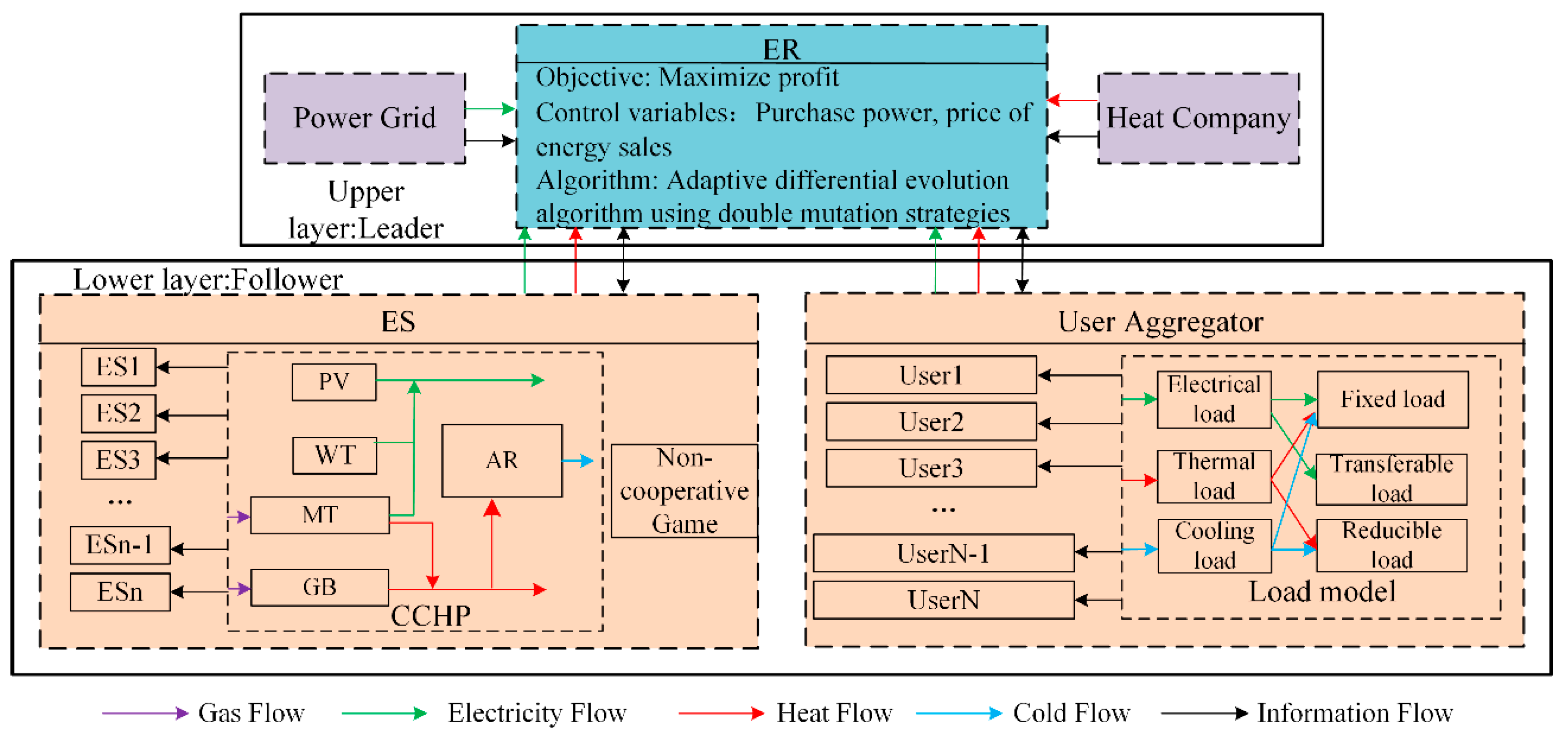
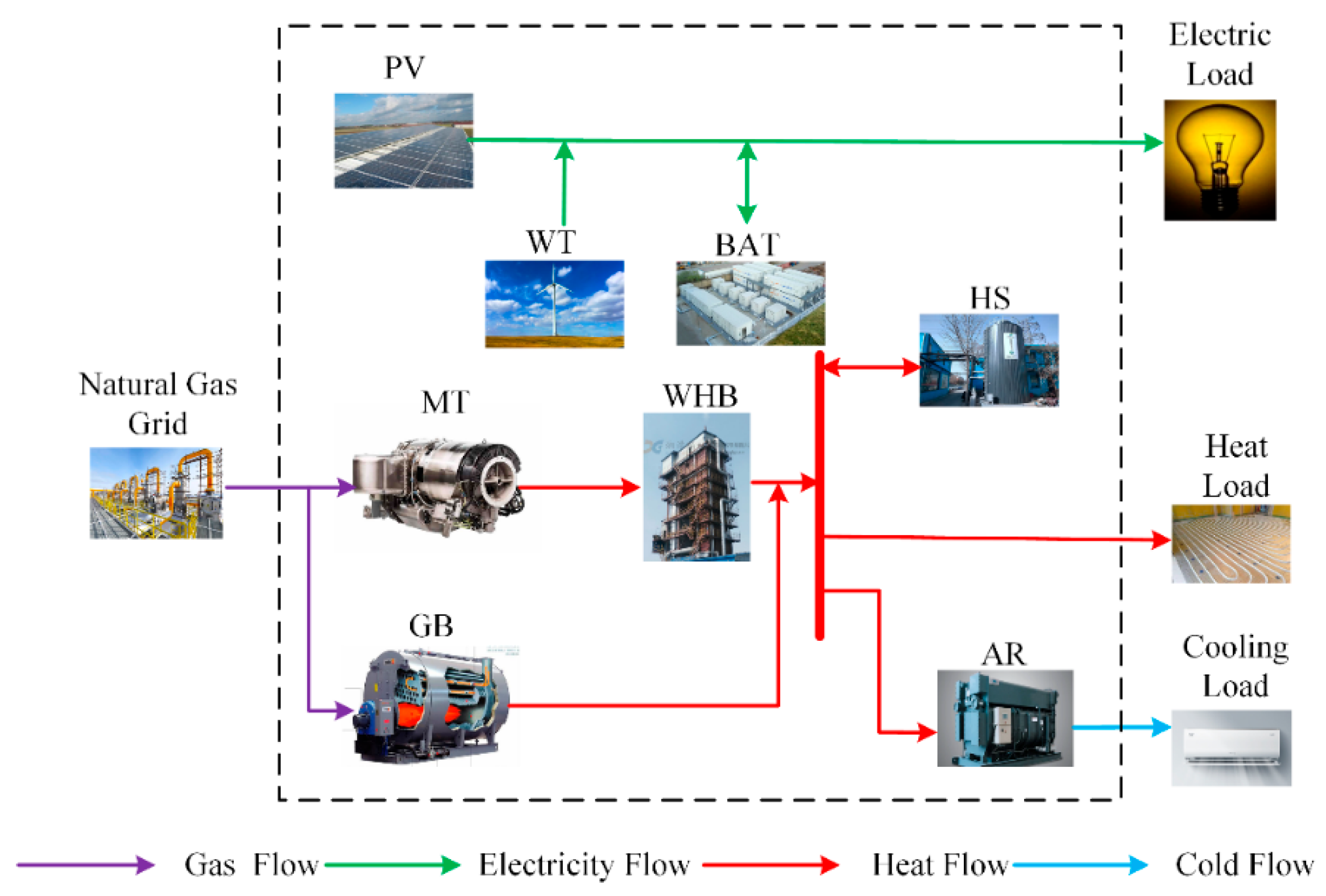
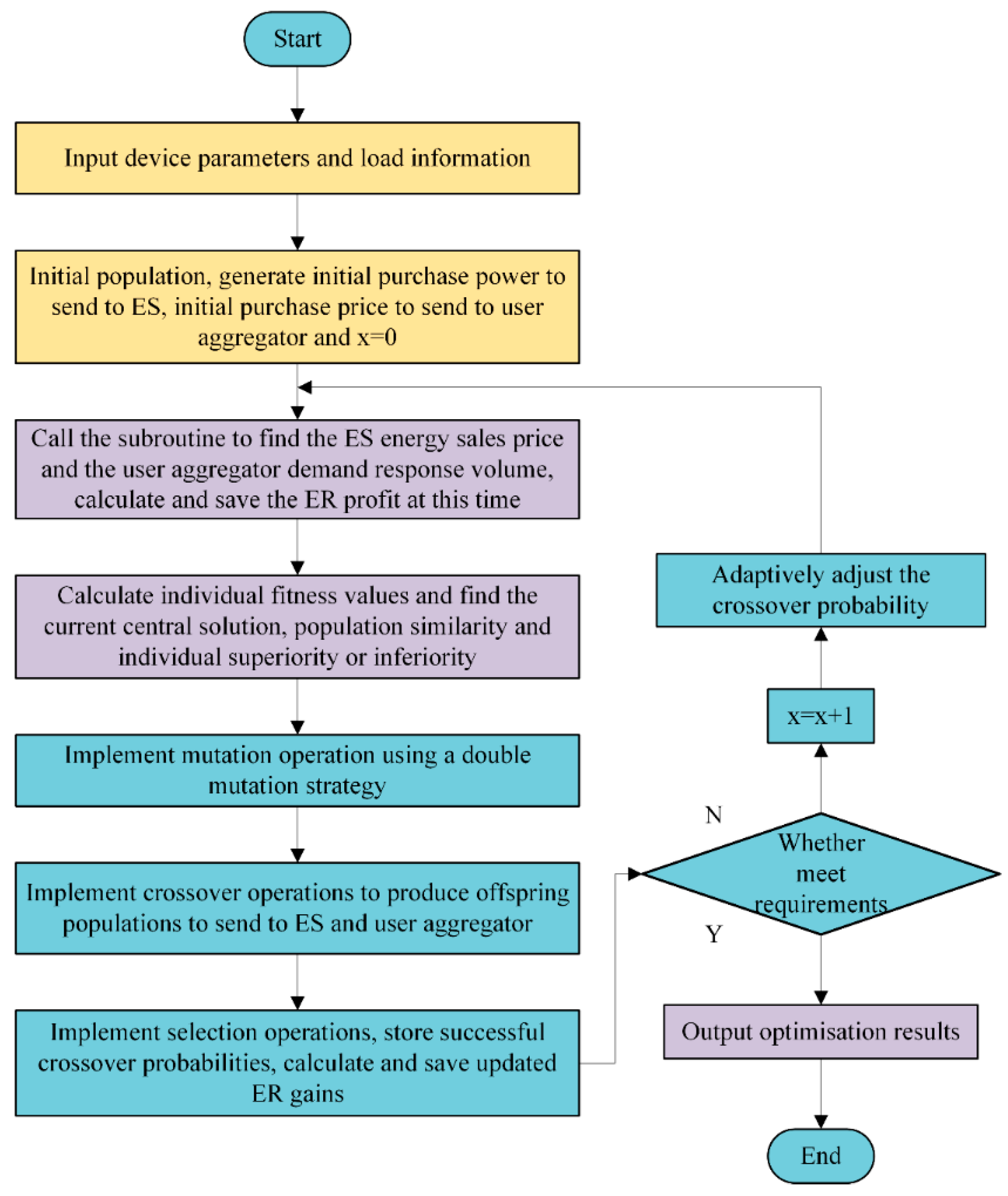
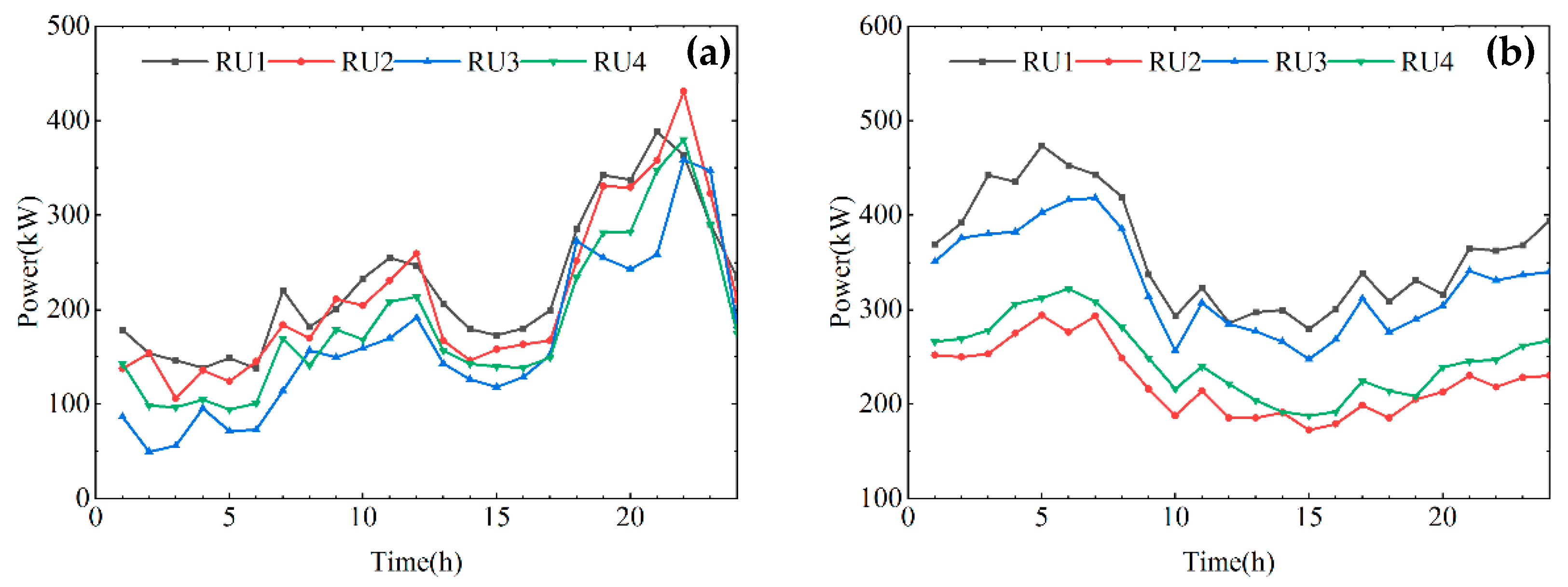

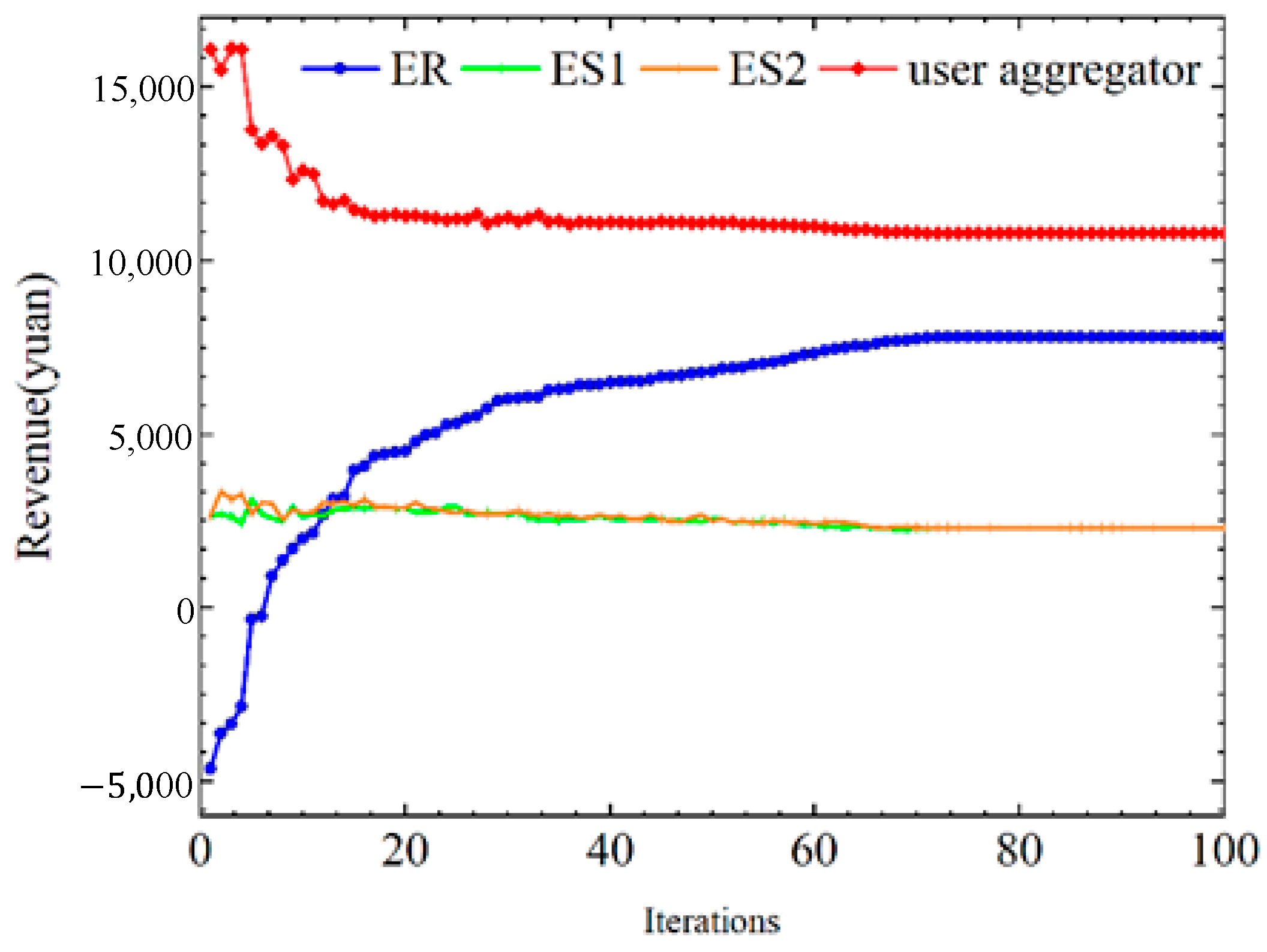
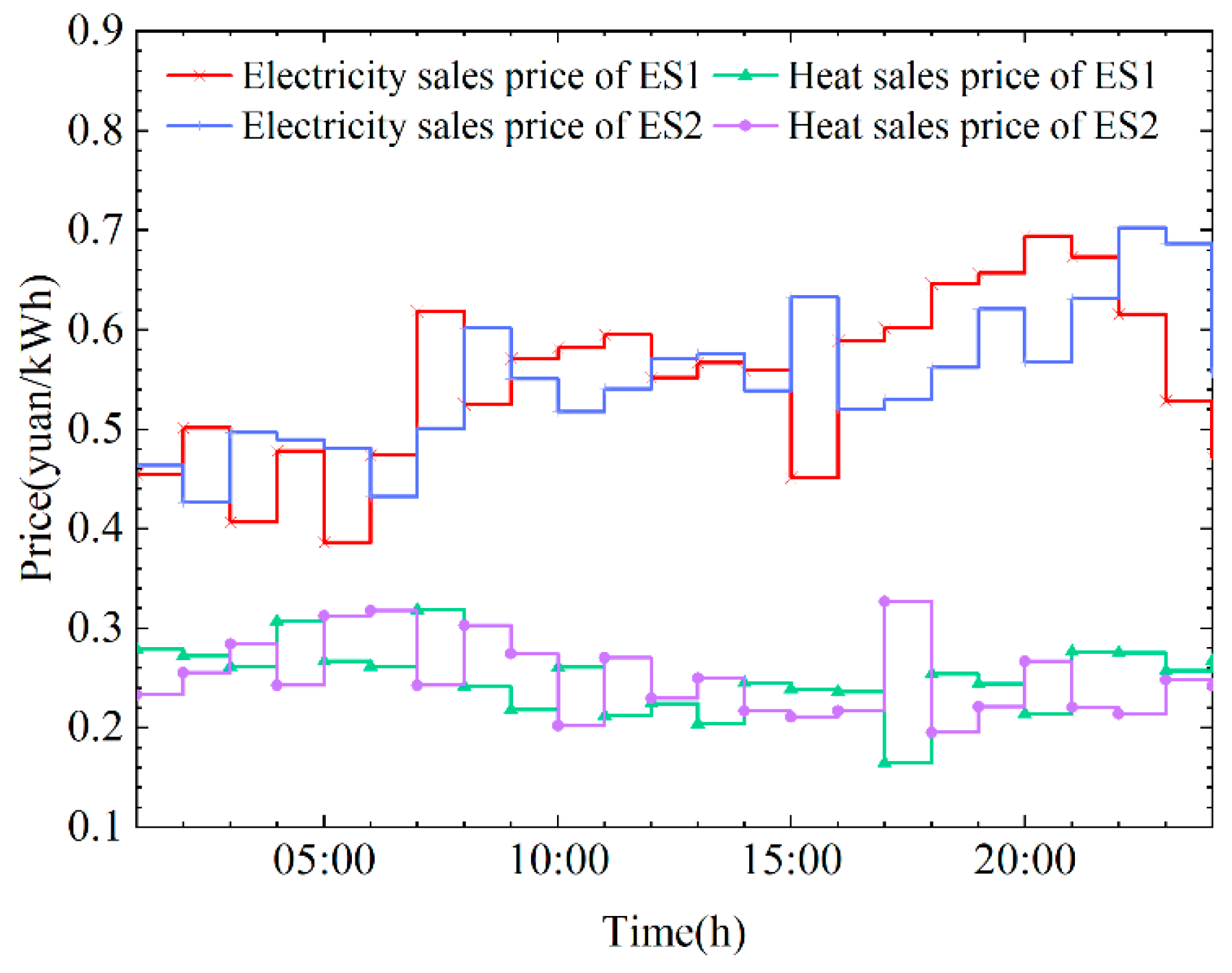
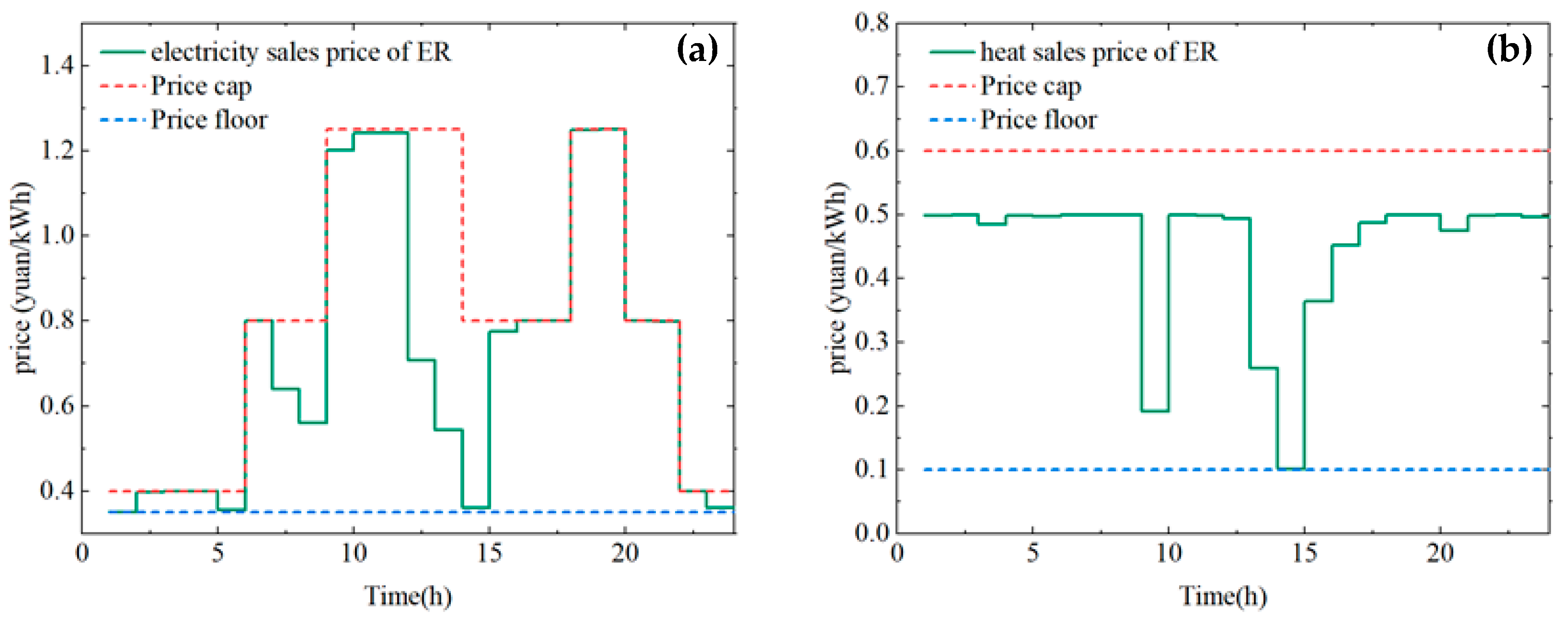
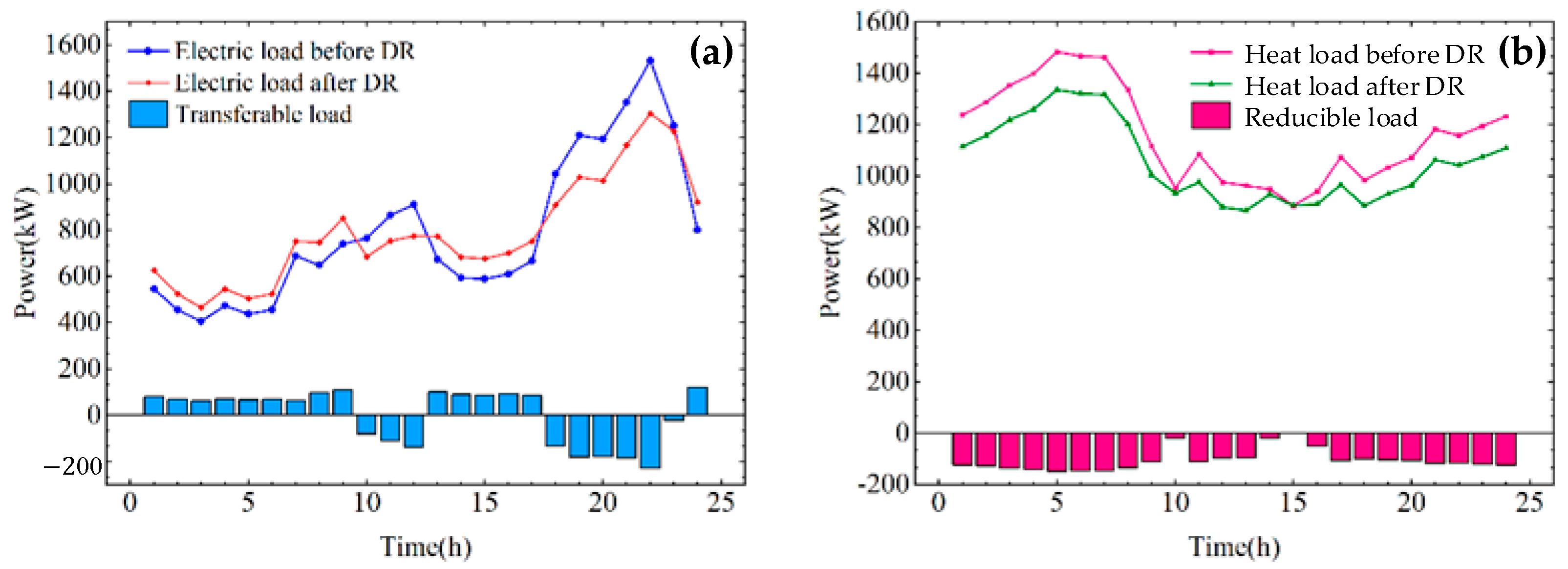

| Variables and Abbreviations | Specific Meaning | Variables and Abbreviations | Specific Meaning |
|---|---|---|---|
| IES | integrated energy systems | , | the carbon allowances of ER and ESi |
| DR | demand response | , | the purchasing of electricity and heat by ER |
| CTM | carbon trading mechanisms | , | the carbon emission allowances per unit of electricity and heat |
| IESO | integrated energy system operator | , | the actual carbon emissions of ER and ESi |
| SMMS | single-master–multiple-slave | the sum of MT and GB output power of ESi | |
| ER | energy retailer | , , , , , | the carbon emission calculation factors for coal and natural gas-fired energy plants |
| ESs | energy suppliers | the carbon trading cost | |
| CIES | community integrated energy system | the overall revenue of ER in a single day | |
| CCHP | cooling, heating, and power | the revenue of supplying energy to users | |
| PV | photovoltaics | the cost of purchasing energy from ESs | |
| WT | wind turbine | , | the cost of purchasing electricity and heat |
| BAT | storage batteries | , | the demand for electricity and heat load of the kth class of users |
| MT | micro gas turbine | , | ER’s electricity and heat prices |
| WHB | waste heat boiler | , | ER’s electricity and heat power purchased from ESi |
| AR | absorption refrigerator | , | the electricity and heat selling price of ESi |
| GB | gas boiler | , | the electricity and heat price from the higher level purchased by ER |
| HS | heat storage | the overall revenue of ESi | |
| residual heat generated by MT of ESi | the fuel cost incurred by the MT and GB of ESi | ||
| the output power of MT of ESi | the operation and maintenance costs for equipment of ESi | ||
| , | generating efficiency and heat loss factor of MT in ESi | the energy storage unit operation and maintenance costs of ESi | |
| the output thermal power of WHB | , | the base electricity and heat prices of ESi | |
| the heat recovery efficiency of WHB | , | the coefficients of fluctuation of electricity and heat prices for ESi | |
| the refrigeration power of AR of ESi | the user’s energy utility | ||
| the refrigeration efficiency of AR of ESi. | , , , | the preference coefficients for electricity and heat |
| Categories of Users | Parameter | Value |
|---|---|---|
| RU1 (users who prefer both electricity and heat) | 1.6, 0.004 | |
| 1.2, 0.003 | ||
| RU2 (users who prefer electricity) | 1.6, 0.004 | |
| 1.0, 0.005 | ||
| RU3 (users who prefer heat) | 1.4, 0.006 | |
| 1.2, 0.003 | ||
| RU4 (general users) | 1.5, 0.005 | |
| 1.1, 0.004 |
| Parameter | Value | Parameter | Value |
|---|---|---|---|
| /kW | 500 | 0.02 | |
| /kW | 600 | 0.41 | |
| /kW | −230, 230 | 0.09 | |
| /kW | −300, 300 | 0.85 | |
| /kW | 450 | 0.007 | |
| /kW | 500 | 0.02 | |
| /kW | −220, 220 | 0.38 | |
| /kW | −250, 250 | 0.07 | |
| 0.016, 0.018, 0.02, 0.02 | 0.83 | ||
| 0.02, 0.02, 0.015, 0.015 | 0.252 | ||
| 0.0068 | /% | 25 |
| Operation Mode | User Classification | IDR | CTM | Non-Cooperative Game |
|---|---|---|---|---|
| Mode 1 | × | √ | √ | √ |
| Mode 2 | √ | × | √ | √ |
| Mode 3 | √ | √ | × | √ |
| Mode 4 | √ | √ | √ | × |
| Mode 5 (this study) | √ | √ | √ | √ |
| Operational Indicator | Mode 1 | Mode 2 | Mode 3 | Mode 4 | Mode 5 | |
|---|---|---|---|---|---|---|
| Revenue (CNY) | ER | 7728 | 8370 | 7871 | 8233 | 7810 |
| user aggregator | 7737 | 8581 | 10,911 | 10,901 | 10,794 | |
| ES1 | 1669 | 1440 | 3356 | 1786 | 2283 | |
| ES2 | 3114 | 1590 | 4033 | 1934 | 2295 | |
| Carbon emissions (kg) | ER | 2406 | 2997 | 7831 | 3150 | 2611 |
| ES1 | 12,249 | 13,622 | 12,128 | 10,611 | 10,446 | |
| ES2 | 11,890 | 16,528 | 17,862 | 12,608 | 12,659 | |
| Total carbon emissions (kg) | 26,545 | 33,147 | 37,821 | 26,369 | 25,716 | |
| Carbon trading costs (CNY) | ES1 | 1443 | 1733 | - | 1156 | 1299 |
| ES2 | 1388 | 2258 | - | 1501 | 1890 | |
Disclaimer/Publisher’s Note: The statements, opinions and data contained in all publications are solely those of the individual author(s) and contributor(s) and not of MDPI and/or the editor(s). MDPI and/or the editor(s) disclaim responsibility for any injury to people or property resulting from any ideas, methods, instructions or products referred to in the content. |
© 2025 by the authors. Licensee MDPI, Basel, Switzerland. This article is an open access article distributed under the terms and conditions of the Creative Commons Attribution (CC BY) license (https://creativecommons.org/licenses/by/4.0/).
Share and Cite
Fu, J.; Gong, L.; Wei, Y.; Zhang, Q.; Zou, X. Optimal Operation of a Two-Level Game for Community Integrated Energy Systems Considering Integrated Demand Response and Carbon Trading. Processes 2025, 13, 2091. https://doi.org/10.3390/pr13072091
Fu J, Gong L, Wei Y, Zhang Q, Zou X. Optimal Operation of a Two-Level Game for Community Integrated Energy Systems Considering Integrated Demand Response and Carbon Trading. Processes. 2025; 13(7):2091. https://doi.org/10.3390/pr13072091
Chicago/Turabian StyleFu, Jing, Li Gong, Yuchen Wei, Qi Zhang, and Xin Zou. 2025. "Optimal Operation of a Two-Level Game for Community Integrated Energy Systems Considering Integrated Demand Response and Carbon Trading" Processes 13, no. 7: 2091. https://doi.org/10.3390/pr13072091
APA StyleFu, J., Gong, L., Wei, Y., Zhang, Q., & Zou, X. (2025). Optimal Operation of a Two-Level Game for Community Integrated Energy Systems Considering Integrated Demand Response and Carbon Trading. Processes, 13(7), 2091. https://doi.org/10.3390/pr13072091





